Archduke Eugen of Austria-Teschen
Archduke Eugen Ferdinand Pius Bernhard Felix Maria of Austria-Teschen
(21 May 1863 – 30 December 1954) was an Archduke of Austria and a Prince of Hungary and Bohemia. He was the last Grand
Master of the Teutonic Knights from the Habsburg dynasty. Eugen was the
son of Karl Ferdinand, Archduke of Austria (son of Archduke Charles, Duke of Teschen) and of his wife Archduchess Elisabeth
Franziska of Austria. He was born at the castle of Gross Seelowitz (Židlochovice), near Brünn (Brno) in Moravia,
today in the Czech Republic. At his baptism he was given the names Eugen Ferdinand Pius Bernhard Felix Maria. His
education was Spartan in character. His country living at Gross Seelowitz and holidays at Gmund alternated with a sound education
and strict instruction.
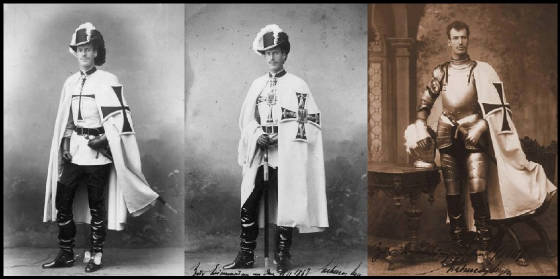
At the Palais Erzherzog Albrecht (Archduke Albrecht's Palace, also known as
the Albrechtspalais) in Vienna, Eugen received instruction in all the military subjects in addition to languages, music
and the history of art. At the age of 14 in keeping with the family tradition and like his elder brother Friedrich, he also
began his military career with the Tyrolean Kaiserjäger Regiment and was commissioned as a Leutnant on the 27 October
1877. Shortly thereafter he was transferred as an Oberleutnant to a hussar regiment and in the following years participated
in many lengthy manoeuvres. In 1882, Eugen took
an examination before a commission assembled by Archduke
Albrecht that verified his suitability to attend the
military academy at Wiener Neustadt. Eugen became then the sole archduke to attend the several year long course at the
academy (1883–1885) and subsequently successfully graduated as a fully trained general staff officer.
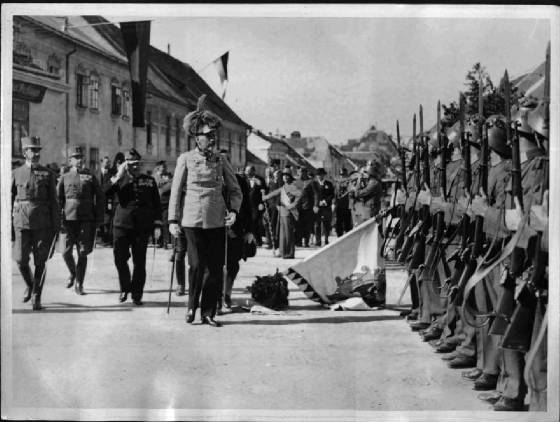
Military career
In 1885, Eugen was assigned to the General Staff and rapidly rose through the ranks. He
commanded a battalion of Infantry Regiment 13 as a lieutenant colonel before assuming command of the entire regiment as a
colonel. Following a further regimental assignment as commanding officer of Hussar regiment 13, he assumed command of an
infantry brigade in Olmütz and then a division in Vienna. In 1900 he was appointed to the command of XIV Army Corps in
Innsbruck and promoted to General der Kavallerie on 27 April 1901. This command simultaneously also made him the commanding
general in Innsbruck and the defence commander for the Tyrol. He was appointed eight years later as an army inspector and
senior defence commander for the Tyrol. When in 1909 the possibility of a war against Serbia was in the air he alongside
Archduke Franz Ferdinand and General Albori was named as a presumptive army commander. Eugen also had exercised his influence in the field of personnel. He had urgently recommended
Feldmarschallleutnant Conrad von Hötzendorf, his divisional commander at Innsbruck as the successor to the
retiring chief of the general staff — General Beck-Rzikowsky. In 1911, the Archduke retired from active military
service ostensibly for health reasons. Conrad von Hötzendorf however suggested in his memoirs that Archduke Franz Ferdinand
had become increasingly jealous of the importance of Eugen.
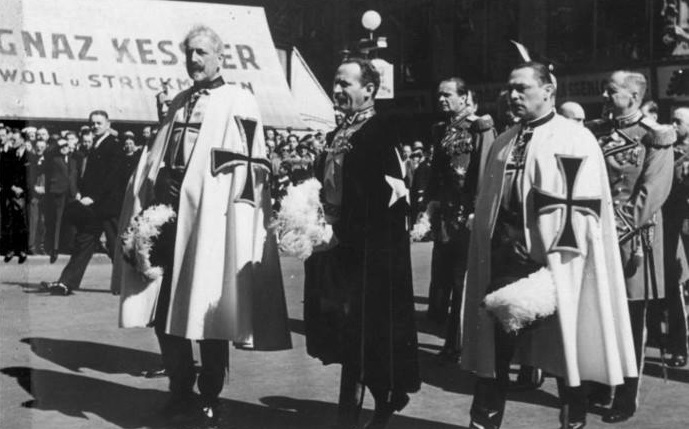
In addition to his military career above all else, Eugen was called
upon to perform his duty as the Grand Master of the Teutonic Knights. On 11
January 1887, Eugen entered the Teutonic Knights as a professed knight. At the same time he was chosen to be the coadjutor
of his uncle, Archduke Wilhelm, then Hoch- und Deutschmeister. When Archduke Wilhelm suddenly died, Eugen was enthroned as the new Hoch- und Deutschmeister on 19 November
1894 and in this office he also proved himself very
effective. He further developed the institution of the volunteer nursing care (Marianer), founded new hospitals and improved
the training of the sisters. Finally he had the central archives of the order in Vienna sorted out and extended.
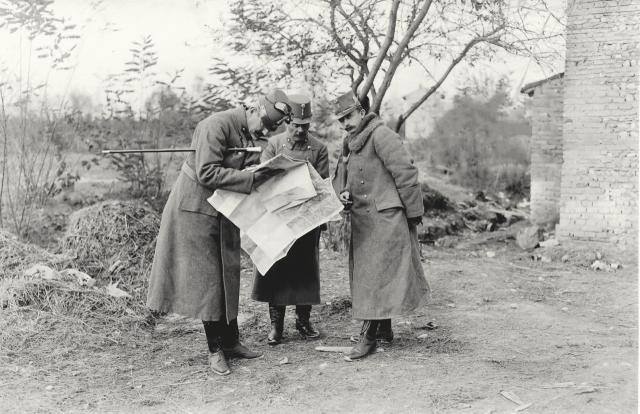
World War I
At
the outbreak of the First World War he immediately reported for active duty. He was however at first palmed off with a relatively unimportant post as the patron of the voluntary war welfare organization. Finally he
was transferred in December 1914 to replace Oskar Potiorek and assume the post of commander of the forces in the Balkans
with his headquarters at Peterwardein. Together with his chief of Staff, Feldmarschall-Leutnant Alfred Krauss, a very talented
military theoretician with a decisive and vigorous character, he reorganized the hard hit 5th Army. On 22 May 1915, Eugen
was promoted to Generaloberst. Two days later on the 24th of May he was entrusted with the command of the southwestern front
against Italy. He moved his headquarters to Marburg (Maribor) and now commanded a theatre stretching from the Swiss border
to the Adriatic. His main objective here was a pure and simple defence against the many times numerically superior Italian
forces. Only at the beginning was the designation "Southwest Front Command" clear. From March 1916, it functioned
as Heeresgruppen-Kommando Erzherzog Eugen in Tyrol to the exclusion of the remaining parts of the front and at the
beginning of the execution of the 12th battle of the Isonzo as Heeresfront Erzherzog Eugen with the allied German
14th Army and Heeresgruppe von Boroević under command but Heeresgruppe von Conrad was not immediately subordinate.
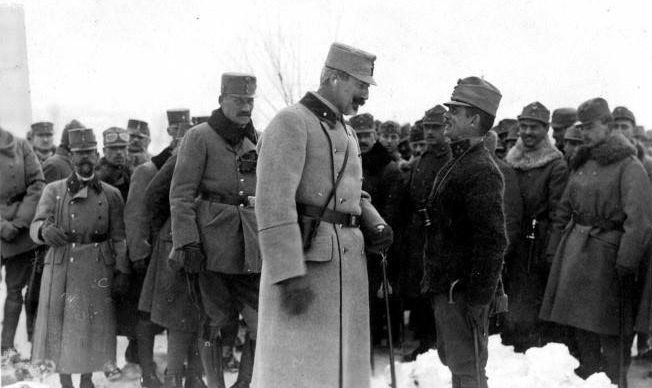
During the First Battle of the Isonzo Eugen traveled back and forth
behind the front. He attended many conferences, appeared on the front lines and encouraged the troops and in this way achieved
great popularity. At the same time he managed the rear areas in order to guarantee the best possible supply to the forward
troops. Before the great attack from the South Tyrol which took take place in the Spring of 1916 Eugen assumed command
as army group commander of the 11th and 3rd armies and took up headquarters at his cousin's, the Graf von Bozen und Maurer,
estate just outside Bozen (Bolzano). After initial success, the attack had to be broken off in consequence of the danger posed
to the Russian front following the Brusilov Offensive of June 1916 and the subsequent transfer of formations to that threatened
front. However, after breaking off the offensive, Archduke Eugen successfully withdrew his troops in the second half of June
1916 into secure positions. In the further course
of the war Eugen had to transfer more and more of his troops to the hard fighting Isonzo Army so that he soon had to manage
without reserves in his own theatre of operations. Although he had had only a very limited forces holding the Tyrolean front
he never considered withdrawing further and shortening his line. He was too personally attached to the land to do that. Eugen
was promoted to Field Marshal on 23 November 1916 and in the middle of March 1917 again took up his work as the commander
of the southwest front. During the Caporetto offensive, Eugen was the actual commander employing his complete energy in the
process. He recognized that this was the last favorable opportunity for the Central Powers. The Archduke, who normally
was no great flayer of the soldiers could on this occasion not push hard enough. There appeared temporarily to be great
confusion in the issuing of orders. It is possible that many blamed Eugen and his staff for this.
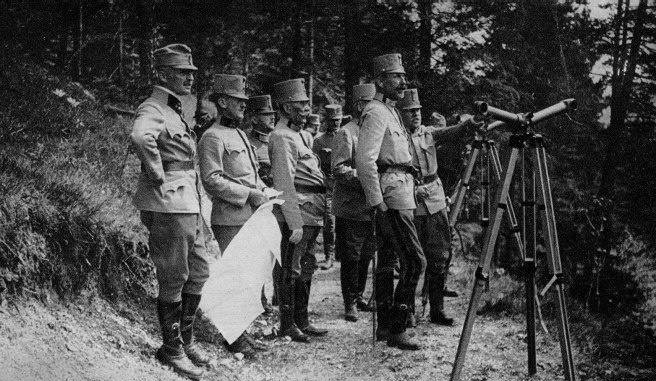
Against the will of the chief of the general staff, Generaloberst Baron
Arz von Straußenburg, the Emperor Karl released Eugen from active service on 18 December 1917. The southwestern front
command was terminated. The relief of Eugen does not appear to have been made for personal but on objective reasons. After
Russia's withdrawal from the war and the shortening of various other fronts (Isonzo, Carinthia, Dolomites), the senior generals
pushed at the Piave. With his very senior rank, Eugen could only be a commander in chief. But as the Emperor Karl himself
took up the supreme command Eugen had to go. Eugen still enjoyed high renown and at the end of the war at the beginning
of November 1918, the idea of Eugen becoming a regent was introduced. The last foreign minister Graf Andrassy and the member
of parliament Dr. Franz Dinghofer of the German nationalist party had discussed this. However, Eugen would never have accepted
such an offer without the consent of the emperor.
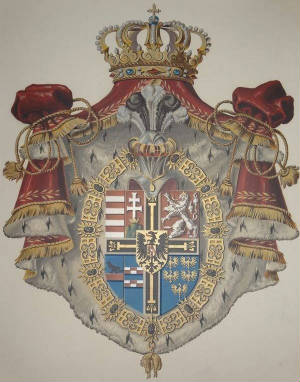
Military awards
Amongst the Archduke's considerable number of Austro-Hungarian awards here are
the most important:
- Order of the Golden
Fleece (13 April 1878)
- Military Merit Cross
(30 November 1898)
- Jubilee Commemoration
Medal (2 December 1898)
- Military Service
Award III Class (24 October 1902)
- Bronze
Military Merit Medal (26 September 1905)
- Brilliants
to the Military Merit Cross (12 August 1908)
- Second
Expression of Appreciation (Silver Military Merit Medal 1911) (11 October 1908)
- Military Jubilee Cross (2 December 1908)
- Grand Cross of the Order of Saint Stephen of Hungary (30 March 1911)
- Red Cross Merit Star with War Decoration (8 March 1915)
- Bronze Military Merit Medal (War ribbon) (9 May 1915)
- Military Merit Cross 1st Class with War Decoration (29 July 1915)
- Large Military Merit Medal (24 May 1916)
- Grand Cross of the Military Order of Maria Theresa (15
January 1917)
- Silver Military Merit Medal
with Swords (26 June 1917)
- Brilliants to
the Military Merit Cross 1st Class with War Decoration and Swords (5 November 1917)
He also received the Swords to both his Large Military Merit Medal and Bronze
Military Merit Medal at a later date to the original awards.
Additionally he was the possessor of a host of foreign awards and decorations:
- Grand Cross of the Order of the Star of Romania (3 October 1881)
- Grand Cross of the Royal Spanish Order of Charles III
(2 July 1883)
- Throat and Breast Cross of
a Professed Knight of the Teutonic Order (11 January 1886)
- Grand Cross of the Royal Portuguese Military Merit Order (7 March 1890)
- Grand Cross of the Grand Duke of Hesse Ludwig Order (5 May 1892)
- Throat and Breast Cross of the Hoch- und Deutschmeister (30 July 1894)
- Grand Cross of the Grand Ducal Tuscan Order of St. Joseph
(7 April 1896)
- Imperial Russian Order of
St. Andrew with Chain (26 June 1896)
- Imperial
Russian Order of St. Alexander Nevsky
- Imperial
Russian Order of the White Eagle
- Imperial
Russian Order of St. Anna 1st Class
- Siamese
Order of the Royal House of Chakri (17 September 1897)
- Royal Order of the Seraphim (10 October 1897)
- Royal Swedish Jubilee Commemorative Medal
- Papal Order of Christ (17 February 1904)
- Grand Cross of the House Order of Saxe-Ernestine (5 June 1904)
- Collar of the Royal Spanish Order of Charles III (21 June 1907)
- Grand Cross of the Papal Order of the Holy Sepulchre (24 September 1907)
- Grand Cross of the Royal Victorian Order (20 September 1908)
- Commemoration Medal to the Regency of Queen Maria Christina
of Spain (1909)
- Grand Cordon of the Royal
Belgian Order of Leopold (6 October 1910)
- Royal
Prussian Iron Cross 1st and 2nd Class (30 March 1915)
- Grand Commander of the Royal Prussian Hohenzollern House Order with Swords (4 August 1915)
- Grand Cross of the Royal Bavarian Military Order of Max Joseph (16 November
1915)
- Imperial Ottoman Gold and Silver Imtiyaz
Medals (15 January 1916)
- Friedrich-August
Cross, 1st and 2nd Class of the Grand Duchy of Oldenburg (15 March 1916)
- Royal Prussian Order Pour le Mérite (24 May 1916)
- Grand Cross of the House Order of Vigilance or of the White Falcon with Swords of the Grand
Duchy of Saxe-Weimer (2 December 1916)
- Honour
Award of the Royal Bulgarian Red Cross (1916/1917)
- Oak leaves to the Royal Prussian Order Pour le Mérite (11 November 1917)
- Royal Bulgarian Order of Bravery 1st Class (20 November 1917)
- Grand Cross of the Royal Württemberg Military Merit
Order (2 January 1918)
- Royal Bavarian Honour
Award to commemorate the Golden Anniversary of King Ludwig III (20 January 1918)
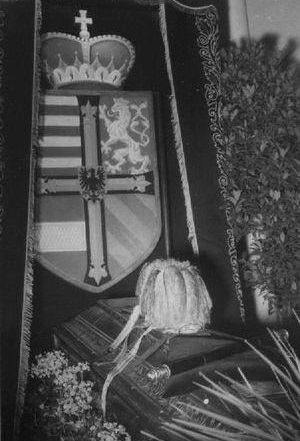
Later life
Following the
collapse of the monarchy Eugen first settled in Lucerne and then at Basel where he lived modestly in a hotel from 1918 to
1934. In order to safeguard the existence of the Teutonic Order, Eugen voluntarily resigned his position as the Hoch-
und Deutschmeister in 1923. He had been the last hereditary grand master of the order. In this way the possessions of
the order were saved. In 1934, Eugen settled at
the order's convent at Gumpoldskirchen near Vienna. He participated at monarchical rallies, attended
veterans' meetings and placed himself again at the service of the dynasty even though he himself no longer believed in the
restoration. Following the Anschluß of Austria to Germany in 1938 the Teutonic Order was dissolved
and its possessions confiscated.
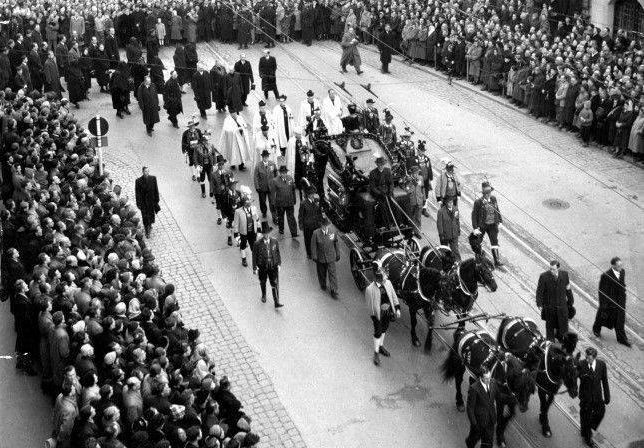
Eugen received, probably with the intervention of Hermann Göring
and other senior military figures, a rented house at Hietzing where he survived the Second World War. In 1945, he fled to
the Tyrol where he received through the French occupying power a small rented villa at Igls. On 21 May 1953, the whole of
Innsbruck celebrated the field marshal's 90th birthday. Eugen died on 30 December 1954 at Meran, at the time part of Italy, surrounded by the brothers of his order
from Lana. On 6 January 1955, he was buried in the St. Jakobskirche at Innsbruck next to Archduke Maximilian III (1558–1619).
